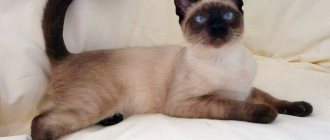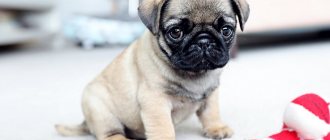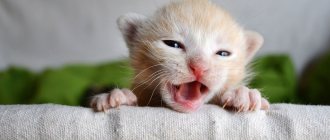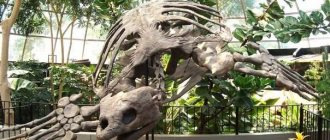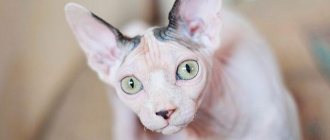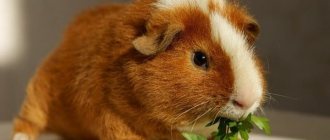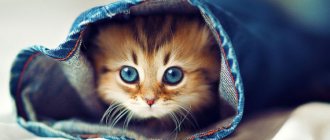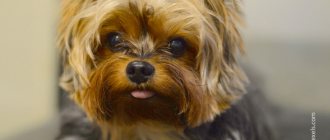| Origin | Great Britain |
| Usage | Hunting |
| Color | Two-color and three-color |
| Dimensions | Height 30-40 cm; basset hound weight 17-30 kg |
| Lifespan | 11-14 years old |
A dog with sad eyes and ears sweeping the floor is the first impression when seeing a dog called a Basset Hound. This clumsy creature on short legs, stepping on its ears, gives the deceptive impression of a melancholy and indifferent creature. In fact, hounds are one of the most sensual and impressionable, and if a friendly relationship has developed with the owner, then the basset will remain a faithful and devoted companion until the last breath. Characteristics of the breed, whose historical purpose was hunting, and now - a companion, will help you get to know the Basset Hound better.
Origin story
Do you want to get a basset hound?
Yes
0%
While I'm thinking
0%
Has already!
0%
The ancestors of the Basset Hound are considered to be French short dogs. Basset (translated from French means low sitting). The animals were brought to England, where hunting enthusiasts noted the dogs’ unsurpassed working abilities. In the process of crossing with bloodhounds, a new breed appeared - the basset hound. The dog with an amazing look became a favorite of both hunters and ordinary residents, and the breed began to spread throughout England. At the end of the 19th century, a club of lovers of these hounds was formed, the basset hound was recognized as a separate species and began its triumphant march throughout the world.
The appearance of the breed in Russia is interesting. In 1976, the French film “Acquaintance by Marriage Announcement” with the participation of a basset hound was released on the wide screen in the USSR. Until this moment, no one had seen such a dog in the country. Many were interested in this unprecedented beast. So we can say with confidence that the basset hound’s acquaintance with our country happened through an advertisement.
History of the breed
The Basset Hound is a true European. Officially, its homeland is Great Britain, but don't tell that to the French. It was in France that low-legged hounds have long been cultivated, they were called bas.
The old-type bass differed from the main stock of hounds in its slow speed, good scent and viscosity. A dog with such characteristics was needed by foot hunters, in contrast to packs of fast hounds of the mounted nobility. The bass was diligently following the trail of a small animal: a hare, a rabbit, a fox, a wounded roe deer and a wild boar.
The selection of hounds was carried out exclusively on working characteristics, but the result was a dog that was unique in appearance: massive, low, with an elongated body and short limbs. So in the XIV-XIV centuries. a prototype of the artesian-Norman basset appeared.
By the 18th century the general phenotype of the breed was formed, although in different regions of France and different amateur breeders had their own preferences. However, short-legged plants gradually disappeared, and the reason for this was the spread of firearms and the lack of interested selection.
The original hounds were actually revived by the French breeders Lecoute and Lan. The dogs attracted the attention of the British and were brought to the island in 1863 and 1866.
In England there were no hounds of this type, but immediately there was a desire to strengthen and consolidate not the working, but the exterior differences. To achieve this, the bass was crossed with the bloodhound. The dogs acquired powerful, expressive heads with dark sunken eyes and jowls, unique ears and skin that sagged in places. Along the way, the complex temperament of the big blood hound also passed on to the basset hound.
The work of English breeders was prudent and purposeful, and the result was obtained very quickly. Already in 1883, the Basset-Club formed the first standard of the new breed.
In England, foot chasing was not popular, but over time, gentleman hunters began to feel oppressed in their favorite parfors hunt and turned their attention to basset hounds. The non-standard appearance of the new hound spoke of its decorative orientation, but in such a short time the dogs did not lose their main hunting quality - the ability to follow the scent faithfully and for a long time. The Basset remained a hound - a hound.
Nevertheless, the future fate of the breed was predetermined: decorative purpose, exhibition shows and the role of a companion. It was in this capacity that the Basset Hound conquered other European countries, America and Russia.
Breed standard
Compliance with breed standards is an essential condition for breeding and participation in exhibitions.
Its future exhibition life depends on how a basset hound looks. Table of standard characteristics of the basset hound
| Name | Description |
| Frame | Long, squat. The chest is proportional to the whole body: not sunken, but not protruding either. Wide, straight back, without arches or “camel hump”. |
| Head | Large, wide in the frontal part and gradually tapering towards the nose. The jowls of the upper lips hang down and overlap the lower jaw. The profile of the muzzle is not sharp. |
| Neck | With a lot of skin folds. Muscular, strong, medium length. |
| Ears | The floppy ears are set low and soft to the touch. Ear length: when pulled forward, they should extend 1-2 cm beyond the edge of the muzzle. |
| Eyes | Diamond-shaped, not planted deeply. Brown and light brown colors are allowed. |
| Bite | Scissor-shaped. |
| Color | Two or three colors. |
| Wool | Short, thick. |
| Tail | Saber-shaped, high-set. Thickened at the base and tapering towards the tip. |
| Limbs | The forelimbs are short, muscular and strong. The elbows are pressed tightly to the sternum. The hind legs are straight and parallel to each other. Powerfully developed hips. There are hanging folds of skin over the hock joint and over the paws. |
| Movements | The hind legs create a strong push, the front legs move forward well. With this structure, the movements are confident and strong. |
Basset hounds have the longest ears.
Signs that exclude the breed standard:
- Light yellow eye color.
- Malocclusion: overbite or underbite.
- Broken metacarpus.
- One-color coat color.
The description of the breed and the first standards were officially adopted in 1900, and since then have undergone almost no changes.
Character and training
The Basset is not as phlegmatic as it seems. Normally, this is a calm, balanced dog, ready for long-term work and friendly relationships. Cowardice and infantilism are just as uncharacteristic of the Basset Hound as anger and aggressiveness.
Being a viscous, persistent hound, the Basset Hound is not prone to quick switches of activity and violent manifestations of emotions - this is detrimental to work. Hence his stubbornness, because the hound should not abandon the trail it has taken and be distracted by extraneous stimuli. Only understanding the hunting nature of the Basset Hound helps owners overcome the difficulties of training.
A good basset dog behaves confidently when walking and in the show ring, which can be seen from its tail. It is difficult to imagine such a dog unquestioningly following commands without special need. Submission to the will of the owner is not in his character. Basset agrees only to interaction.
You might find our article useful: The dog doesn’t listen or “Who’s the boss?!”
Bassets are smart, but they don't advertise it. They love their owner dearly, but show their feelings with restraint.
The Basset cannot be punished except by word and intonation, but this is only allowed for a 100% reason. Innocently punished, the basset takes offense seriously and for a long time, remembers the injustice and can take revenge. He does it like a cat - he leaves a fair puddle in the intended place.
Hounds are pack dogs and feel great in a group. Two or three Basset hounds from one owner is a common occurrence. They do not conflict with strangers, but they also do not seek to communicate.
The Basset has a bassy, impressive voice, which, coupled with an expressive head, can create a deceptive impression, but he will not make a guard. He is too soft in nature.
In an atmosphere of mutual understanding and with good, interesting, long walks, the basset becomes self-confident, quite happy, and can even be playful in its own way. Breed experts pay special attention to checking the temperament of dogs during exhibition inspection.
Character
When you first meet a dog, you get the feeling that this is a lazy and phlegmatic dog, whose purpose is to lie on the sofa and sadly wait for its owner. One look, full of sadness and sadness, is worth it! It should be remembered that basset dogs belong to the hunting dog group. Therefore, they have all the qualities inherent in these dogs. The incredible ability to make independent decisions is due to high intelligence. Bassets are playful, adventurous, capable of tracking down a cat or chasing birds for sport. The dog adores his owner and is ready to come to the rescue at the slightest danger. It is difficult to find a more loving and devoted friend. If all the positive qualities are present, they note a willful character and a fair amount of stubbornness. He has his own mind - this is how you can characterize the personality of a basset hound.
Despite the apparent passivity and indifference, the Basset Hound has a hard time enduring loneliness. It is not recommended to get a hound for people who rarely come home. The dog will be sad, and in order to attract attention, he is capable of organizing a boycott: spoiling things, marking corners, howling and barking loudly until the owner returns home.
Dog character
In general, the personality of Basset Hounds is docile and friendly. They are very patient with children and other pets. Dogs do not like to be left alone, which should be taken into account when choosing a pet breed.
If a basset sits alone in the house for a long time, it begins to howl and moan loudly.
The disadvantages of the breed include the habit of running away, a tendency to obesity, and the fact that they often do not lend themselves to the standards of regular dog training.
Physically, Basset Hounds are very resilient and love long walks, especially in the company of their beloved family members. Overall, we can say that Basset Hounds make excellent friends and companions.
Dogs are considered quite universal, so a person with any temperament can easily find a common language with him.
Application
In the recent past, Basset Hounds were passionate hunters. Widely used by humans in catching rabbits and small game. Basset hounds are known to be used for truffle extraction. Nowadays, dogs rarely manage to realize their hunting instincts. Basset hounds are increasingly being adopted as companions for children or single people. The dog will be happy to accompany you on long walks and car trips.
Price of puppies
This breed is not very common in our country now, so the price of a Basset Hound puppy often ranges from 150 to 700 dollars. USA. The cost depends on the breed standard, the pedigree of the dog and its color.
When choosing a basset hound as your friend, you can be sure that the dog will become the favorite of all family members, and in return will also give a lot of adoration and positive emotions.
Socialization
It will take a long time for a Basset Hound to be socialized. It's like a baby. The best time for house training is from 12 weeks of age. At this point, the puppy’s psyche becomes more stable, and he is ready to change his usual lifestyle. Without socialization, it is impossible to develop a self-confident person.
Meeting other dogs begins in the puppy area, with puppies of the same age. If the baby is kept at home all the time and not allowed to contact other animals and people, then the dog can grow up withdrawn, cowardly and aggressive.
There is a tolerant attitude towards animals living in the same territory. Cats interest him as a hunting object only when walking. If there are small children of preschool age in the family, then they will grow up together. Together they will bully, make friends and find common activities. In this case, the dog will be attached to its little owner.
Of all its brothers, the basset will unmistakably choose a representative of its breed for games and communication.
Description of the Basset Hound breed
In modern realities, short-legged Basset Hounds are most often used as pets and companion dogs . But they have not lost their hunting qualities, since the standard provides for testing their working qualities.
Appearance
The general physique of the Basset Hound is corpulent, massive and squat, but quite balanced and harmonious with a heavy bone frame and developed muscles . A heavy, dense body of a highly elongated format with a well-defined withers, smoothly turning into a flat and wide back, a protruding chest and a slightly arched loin.
The Basset has an original physique - squat and elongated.
Breed standard:
- Height at the withers is 33–38 cm.
- Body weight - 20–35 kg.
- A large head of square outline with a convex dome-shaped skull and a clearly defined bump on the back of the head is set on a powerful long neck with a clearly visible dewlap. The blunt, heavy muzzle (its length is slightly longer than the skull) tapers slightly near the nose. Stop moderate.
- Strong, large jaws in a scissor or regular bite.
- The large nose, protruding beyond the line of the lips, is pigmented black (brown shades are acceptable in light-haired individuals).
- The lips form jowls (the lower one overlaps strongly with the upper one).
- The oval-diamond-shaped eyes are set normally (not bulging, but not sunken). The color of the iris is dark brown (lighter shades are allowed for dogs with light fur). The look is calm, serious, with full self-esteem.
The look of the basset is full of universal sadness
- Long, hanging, thin, very elastic, soft and velvety to the touch, the ears are set quite low (below the eye line) and slightly turned inward.
- The long, thick tail, slightly tapering towards the tip, has a saber-like curve. During movement or when excited, it rises vertically, but never curls.
- Very short, massive, broad-boned, straight limbs with large, well-knit paws, dense and hard pads.
The basset hound moves smoothly, without jerking or visible effort, springily and strongly pushing off with its hind legs, while swinging its front legs well.
Basset hounds run quite quickly, although not very fast.
The skin is elastic and pliable, hanging loosely on the head, forming shallow folds in the eye area and above the eyebrows. The forming skin ridges give the eyes a mournful and sad expression. The short coat is quite hard and dense, smooth and shiny . Long, wavy, soft coats and feathering are not allowed.
The standard allows any colors typical of hounds. The most common:
- tricolor - white and black with tan marks of reddish-brown tones;
- two-color - white and red.
Disadvantages and disqualifying vices
Faults are any deviations from the breed characteristics, the significance and seriousness of which is assessed based on the degree of their impact on the ability of the animal to perform its intended function, as well as on its health and well-being.
The following individuals are subject to disqualification:
- having obvious behavioral or physical abnormalities;
- cowardly and aggressive.
Breed varieties
The breed standard does not provide for Basset Hound varieties . There are several closely related breeds that can be considered as such:
- The Artesian-Normandy Basset is a recognized ancestor of the Basset Hound, distinguished by more curved legs, as well as coarse, slightly elongated hair (color from various combinations of black and white, red, sand, etc.).
- The large Vendeen Basset Griffon has coarse, bristly, slightly elongated hair, which, in addition to the usual colors of 2-3 colors, can be simply white.
- Blue Gascony Basset - with short, strongly curved limbs, blue-roan color (fine, dense black specks on a white background).
- Breton fawn basset - with a long, very hard and coarse coat of golden brick shades.
- Small Vendean Basset Griffon - the front legs are slightly curved or semi-curved, the coat is curly, light in color.
Character and psyche of the breed
Contrary to its mournful and sad appearance, the Basset has a cheerful, cheerful and sociable disposition . A good-natured, soft and flexible dog is extremely attached to all family members, regarding it as his own pack. He is very patient with small children and loves active games and pranks. But when crossing the boundaries of permissibility, he may growl and prefer to step aside.
Basset Hounds love children.
He is almost as loyal to strangers and strangers; when they approach, he will bark a couple of times and calm down at that. He won’t fight for his master’s property either. This breed is not used as a watchman or security guard, because it was bred exclusively for hunting. Devoid of any kind of aggression, this animal easily gets along with any pets, and can even be friends with cats. But still, remembering the hunting past, you should not keep the Basset together with small rodents and birds.
Many owners note the stubbornness and perseverance of their dogs, qualities common to all hounds . For this reason, a small basset hound should be raised from the first days of its appearance in the house, because at a young age, training is much easier. Dogs have a habit of completely ignoring commands given to them when they do not want to carry them out. Having chosen a place in the house for themselves, they will never agree to change it; the owners will have to move.
Bassets know a lot about pleasure and often behave like real sybarites. They love to eat delicious food and watch TV with their owner, lounging on a soft sofa.
Basset Hounds love to lie on their master's bed.
They need constant communication, loneliness is extremely difficult to bear. Left alone for a long time, they don’t know what to do with themselves other than eat and sleep. They begin to howl out of anguish and boredom, and the basset's voice is unusually thick and bassy. However, a pet can show its vocal abilities without any reason, simply because it wants it at the moment.
Smart and quick-witted animals are curious and show keen interest in everything.
How to choose a puppy
Before choosing a puppy, you need to decide on the purpose of purchase. Will the dog become a pet-companion or is it planned to raise a champion? What disadvantages are typical for this breed, where you can buy it, how much a puppy costs - these questions will be answered at the kennel club. Experts will advise on the specifics of maintenance and care. They will tell you about the breed and the documents that must be with you when purchasing.
You can look for a pet on the Internet, in private advertisements, but there are pitfalls here. If you're lucky, you can get a wonderful elite copy. But you can run into scammers who hide the animal’s flaws.
You shouldn't take the first puppy you come across. It's better to look at several litters. It’s a good sign if the breeder is cooperative and offers to visit the nursery. Decent and honest sellers have nothing to hide; they will demonstrate the living conditions of the bitch and cubs. The room where children live should be clean and spacious. Basset puppies look well-fed, active, and curious. The eyes and nose are without any discharge, the coat is shiny and smooth. When palpated, the tail should be free of creases. The puppy has a mark in the groin - it must match the data indicated on the card. In rare cases, the mark is placed on the inner surface of the ear. The bitch may be slightly thin, because she is feeding the offspring. Her behavior should not be aggressive or cowardly.
Breeders who love their business will be happy to show photographs of the father and previous litters, and tell everything about the breed and their charges.
A healthy basset puppy is always hungry; you should ask the breeder to feed the baby - this way you can assess his appetite and activity. The main point is health. After all, when buying a friend, you want to enjoy life with him, and not go to the doctors.
Features of maintenance and care
Before adopting a Basset Hound dog into your family, you need to know the specifics of care and maintenance. Bassets are the record holders for the number of abandoned dogs; not every person can cope with raising an animal.
Grooming
The process of caring for the coat is simple, because it is short. Daily brushing with a natural bristle brush promotes faster coat renewal, especially during the molting period. Basset Hounds, accustomed to a comb from an early age, are happy to expose their sides. Besides, an extra minute of communication with the owner will not hurt.
Ear care is a mandatory daily procedure. Drooping ears are poorly ventilated and there is a high risk of inflammation. In the spring and summer, the dog's ears are inspected for ticks after each walk.
Nails are trimmed once every three months. The dog is taught this procedure from an early age in the same way as brushing.
Bathing
The Basset Hound dog has a specific, not very pleasant smell of fur. It is impossible to wash it off. Bathing is carried out 2 times a month using special means. In slushy weather, you will have to wash the dog after every walk due to its physiological characteristics: its stomach is low, so it constantly gets dirty. You can purchase special dog overalls for walking. This way the basset will be protected from dirt.
Walk
One of the problems for Basset Hound owners is training them to cope with their natural needs on the street. The training process can take up to one and a half years. The main thing for the owner is to be patient in practicing the skill. From puppyhood, the dog needs frequent and long walks, 5-6 times a day. Sometimes you will have to take him out for a walk at night.
When walking, the dog is active and inquisitive, like all hunting dogs. If he is carried away by something, then no calls from the owner will help. Having smelled the trail of another animal, he will rush in search of it, and it is impossible to distract him with anything.
Feeding
A balanced diet is the key to successfully raising a puppy and ensuring a long, healthy life for an adult animal. A large number of breeders agree that feeding dry food is the best option. There are also many supporters of natural feeding. Both power systems have their pros and cons.
- Dry food. Ease of use suitable for busy people. The person is confident that the dose recommended by the manufacturer is guaranteed to contain all necessary nutrients and microelements. Vitamin supplements completely meet the dog's needs. Thanks to a clearly calculated daily dose (you need to know how much the dog weighs), it is easy to keep your hound at the desired weight, preventing obesity. There are many medicinal foods aimed at treating allergies and diseases of the digestive tract. When using dry food, it is not recommended to feed your dog natural food. Having enough fresh water is the main condition when feeding dry granulated food.
- Natural food. With this type of nutrition, the main thing is not to overfeed. It is difficult for the owner to resist when the pet looks with a pitiful look, begging for cookies or a piece of sausage. You should not train your dog to use such techniques. If a decision is made on natural nutrition, each owner should know the list of permitted products and the list of strictly prohibited ones. You can find it in the table below.
| Authorized Products | Prohibited Products |
| Milk (strictly up to 4 months of age) | Smoked meats |
| Fermented milk (cottage cheese, low-fat kefir) Pickles | Pickles |
| Lean beef | Butter pastries |
| By-products | Tubular bones of birds |
| Porridge: rice, buckwheat | Fish with large bones |
| Vegetables: both fresh and cooked | Chocolate |
| Fruits: apples, pears | Fruits: banana, grapes, citrus |
Basset Hound Health and Diseases
The Basset Hound has the potential to live a full life of 12–14 years. The necessary conditions:
- Walks.
- Moderate diet.
- Daily regime.
Matings cannot be done without the help of the owners. Basset females give birth on their own, but pregnancy creates difficulties for normal movement.
In addition to the usual canine problems, basset hounds are prone to breed-specific diseases:
- Discopathy. The elongated format creates the preconditions for pinching of the vertebral discs.
- Eye pathologies: ectropion and entropion, glaucoma, “cherry eye” - prolapse of the third eyelid. The basis for the disease is created by damp, drooping eyelids and excess skin on the head.
- Elbow dysplasia.
- Dermatitis of various etiologies.
The Basset Hound is included in the group of dogs with chondrodystrophy (the phenomenon of shortening of the limbs with a normal size of the skull). Hence the general risks due to the genetic nature of the phenomenon. Moreover, this is not only discopathy, but also obesity, skin diseases, false pregnancies.
At the same time, veterinary medicine experts note that the breed is in normal condition and does not pose a genetic threat. For a healthy and long life, basset cats require skillful care of skin folds, ears and eyes, as well as a fair amount of physical activity.
Health
Basset Hounds are in a leading position in terms of health among dogs of other breeds. Life expectancy with good care is up to 14 years.
Diseases
Charming four-legged animals are susceptible to some diseases specific to these dogs:
- Eye diseases: cataracts, glaucoma, conjunctivitis.
- Skin diseases: dermatitis, psoriasis. Often the result of a food allergy.
- Metabolic system diseases (obesity).
- Ear diseases: otitis, allergic reaction.
- Diseases of the musculoskeletal system: spinal disc prolapse, joint dysplasia, paw diseases.
It is not necessary that a Basset Hound dog will suffer from all the ailments on the list. With proper care, careful attention and timely first aid, the dog will live a long and happy life side by side with its beloved owner.
Vaccinations
Preparatory activities include:
- Monitoring well-being and behavior. A healthy puppy is cheerful, active, and has a good appetite.
- Deworming. The presence of parasites in the body reduces the effectiveness of the vaccine.
- Flea treatment.
The first vaccination is given at the age of 8 weeks. Until this age, the puppy is protected by the mother's immunity. There is an exception: if for some reason feeding with mother's milk is impossible (lack of lactation or death of the bitch), then the first vaccination is given at the age of 3-4 weeks.
Table of planned mandatory preventive vaccinations.
| Age | Name |
| 7-8 weeks | Plague, hepatitis, enteritis |
| 11-12 weeks | Revaccination of previously given vaccinations. |
| 6 months | The third vaccination against hepatitis, enteritis and plague. A new vaccine is being added - against rabies. |
| 12 months and then annually | All routine vaccinations (distemper, hepatitis, enteritis, rabies) |
After immunization, the dog is not taken outside for 1-2 weeks and is not bathed for 5-7 days.
Vaccinations are contraindicated during teeth change.
Possible diseases
Reviews from owners about the Basset Hound breed agree that these dogs are extremely resistant to various types of infections. However, there are a number of diseases that the owner should still take note of. It is better if the knowledge is theoretical.
The most common ailment of the breed is von Willebrandt disease, which is acquired hereditarily and is associated with blood clotting problems.
Recently, the number of such diseases has been declining thanks to breeders who have begun to conduct DNA testing of animals that have either just been born or are still in the womb.
Basset hounds make funny faces while running
In addition, Basset Hounds are prone to developing the eye disease glaucoma. It is treated with medication, but if you start it, you can deal with the consequences in the form of complications up to and including complete loss of vision.
This breed also has an extremely delicate gastrointestinal system, which is why gastric torsions are common. Minimum prevention requires that the basset hound rest for at least half an hour after meals. But in the case when a bloat does occur, you cannot do without medical help.
Sometimes basset puppies suffer from panositis, that is, temporary lameness. Its features have not yet been fully studied, but it has been established that attacks of lameness are associated with stress and excessive physical exertion.
The main insidiousness of the disease is that it can be misdiagnosed and the puppy can be treated, including through surgery. Therefore, in this case, it is extremely important to choose a competent veterinarian who is at least familiar with the definition of this disease. Panositis is diagnosed, by the way, by the results of an x-ray. As a rule, the disease disappears by two years.
Another misfortune that could potentially plague Basset Hounds is allergic reactions, not only to food, but also to some types of plants. Exacerbations usually occur in the spring.
The pride of the breed - long burdock ears - are also susceptible to disease. Otitis often develops. The disease can be prevented through regular cleaning and preventive use of a special solution.
Mating
Before breeding, both male and female dogs need to be tested for infections. At the time of the first mating, the dog must be at least one and a half years old. Before mating, it is necessary to check that the bitch has all routine vaccinations. Only in this case will the puppies be reliably protected from such dangerous diseases for dogs as plague and rabies. A bitch is not allowed to breed more than once a year. The last pregnancy is allowed at 6-7 years of age.
The first mating of a male dog takes place with the help of an instructor. The second and subsequent ones - without human intervention.
How much do Basset Hound puppies cost?
The Basset Hound breed is quite common in Russia.
You can buy a basset hound in our country for 5 thousand rubles or 50 thousand rubles. It all depends on the location of the nursery and its reputation. Parents are important. Puppies from owners of titled pedigrees will be more expensive. You can buy a puppy secondhand, the price of such a specimen will be 2-3 thousand rubles. But in this case there are no guarantees of purebred, participation in exhibitions and further breeding is not possible.
If the goal is a pet and not rewards, then you can save money. This will not affect the dog’s relationship with its owner in any way.
Nutrition
The most important thing that future dog owners should take into account is his tendency to obesity. Therefore, it is under no circumstances recommended to overfeed the animal and allow it to bite.
Even despite the sad look that makes the basset hound touching and unhappy, the owner must have a fair amount of restraint and show sternness. Basset hound puppies ideally feed on mother's milk for up to two to three months, and then gradually transition to the adult diet.
The diet for the animal is prepared taking into account the tendency to gain excess weight. Or it will be premium-segment factory food, presented in pet stores. Or it will be natural food, to which additional vitamin complexes must be added.
In addition, the dog needs constant access to a bowl of drinking water. Also, do not forget about the list of prohibited products when it comes to natural feeding.
Basset hound puppies
It is classic and the same not only for almost all breeds, but also for people: a ban on fried, salted, spicy, smoked foods, no chocolate and alcohol. It is worth keeping an eye on your dog on the street as well – basset dogs are prone to “gathering”, picking up sausage skins and other debris directly from the asphalt.
